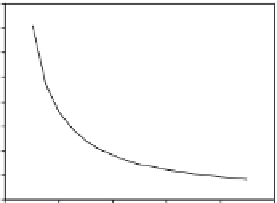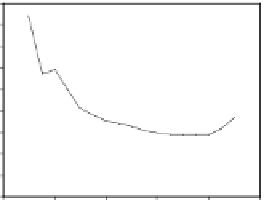Environmental Engineering Reference
In-Depth Information
Results and Discussion
The effect of heavy metal (Fe and Pb) on the complex permittivity was explored.
The results of complex permittivity of saturated soil contaminated with Fe and Pb
versus frequency are shown in
Figs. 3
and
4
respectively. It is easy to note from
Figs. 3
and
4
below that the dielectric constant (real part of permittivity) as well as
the loss factor (imaginary part of permittivity) decrease with increasing frequency
for both pure and contaminated soils. For contaminated soil the results show that
the dielectric constant values are higher than the uncontaminated soil at frequencies
less than 200 kHz, as shown in
Figs. 3a
and
4a
, while at frequencies higher than
300 kHz the opposite trend is observed for both types of heavy metals.
The loss factor (imaginary permittivity) value for contaminated soil is higher
than clean soil as shown in
Figs. 3b
and
4b
. This increase is a result from increasing
the ionic concentration. Therefore, the electric conduction is enhanced by free
movement of charges whereby the ionic constituents act as charge carriers.
b
a
Imaginary Part
Real Part
92
4000
82
3500
Fe 10 mg/L
Clean Soil 0 mg/L
Fe 10 mg/L
Clean Soil 0 mg/L
72
3000
62
2500
52
2000
42
1500
32
1000
22
500
12
2
0
0
200
400
600
800
1000
0
200
400
600
800
1000
Frequency (kHz)
Frequency (kHz)
Fig. 3
The effect of iron on the complex permittivity. (
a
) Real part. (
b
) Imaginary part
b
a
Imaginary Part
Real Part
92
4000
82
3500
Pb 10 mg/L
Clean Soil 0 mg/L
Pb 10 mg/L
Clean Soil 0 mg/L
72
3000
62
2500
52
2000
42
1500
32
22
1000
12
500
2
0
0
200
400
600
800
1000
0
200
400
600
800
1000
Frequency (kHz)
Frequency (kHz)
Fig. 4
The effect of lead on the complex permittivity. (
a
) Real part. (
b
) Imaginary part










































































